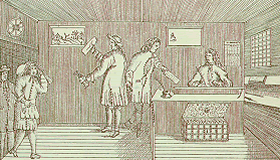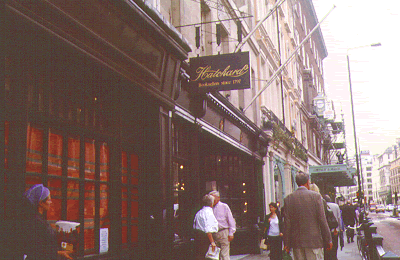The trading City

- The Bank of England
- (late 17th c. engraving)
[click on the picture to enlarge it]
The City was the centre of trade and financial activities.
Sea-trade was carried out on the quays of the Thames.
The Bank of England was founded in 1694, on the plans of a Scotsman, William Paterson, who became its Director, the first Governor being Sir John Houblon, the grandson of a Huguenot. It was meant to manage the national debt caused by the war.
A group of insurance brokers formed in 1688 took the name of Lloyd’s after the coffee-house where they met (business was frequently transacted in coffee-houses, since few purpose-built buildings existed for this).
Hogarth’s paintings, in series like Marriage à la Mode, show the rivalries as well as the alliances between the City and the Court.
Thinkers like Dr. Johnson reflected on the increased role of trade in society.
Numerous trades were also carried out in the shops of London
Shops in the West End
Geographical distribution of commercial activities: If the City was the centre of financial activities, luxury trades would be carried out in Westminster, following the development of squares and townhouses for the fashionable society.

- In Piccadilly:
Hatchard’s (booksellers
founded in the late 18th century)Fortnum and Mason
(originally a shop of delicacies founded
in the early 18th century by one of Queen Anne’s footmen).
[click on the picture to enlarge it]
Various trades would be carried in the streets.

